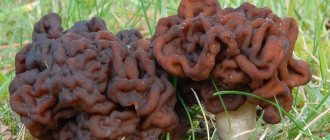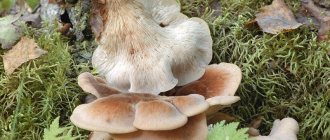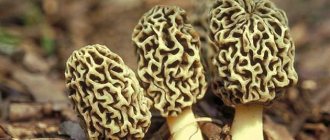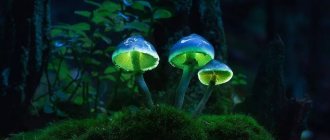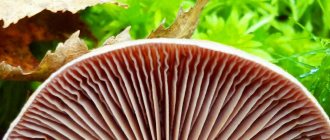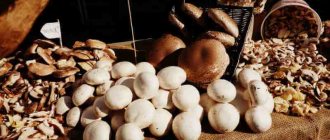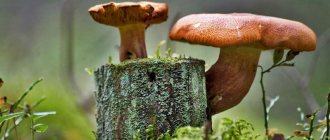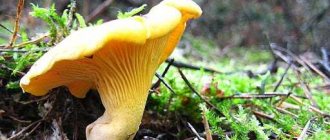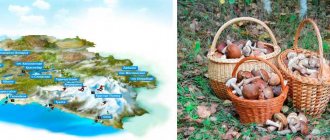The forests of Belarus are rich in natural gifts. The region’s unique climatic conditions will allow lovers of quiet hunting to find a huge number of different types of mushrooms. To prevent the results of a walk in the forest from becoming dangerous, you need to be able to distinguish poisonous from beneficial species.
- Inedible varieties
Mushroom places in Belarus
Most of the mushroom lands are located near Minsk and Vitebsk. The most popular mushroom places:
- Logoischina (Vitebsk direction, forests between the city of Logoisk and the village of Pleschenitsa);
- Khatyn forest area;
- Ilya village;
- Village Stolbtsy;
- Talka station.
Maps of the republic offer developed routes for mushroom pickers. You don’t have to travel far from your place of residence; most mushrooms are found everywhere. Belarus is a territory of mushroom meadows and numerous varieties of useful forest products.
The first edible mushrooms in Belarus begin to be collected in March
How to protect your health? Basic Rules
In order not to remember with grief a quiet hunt, you should collect mushrooms according to the following rules:
1) when going to the forest area alone, you should take a compass and navigator with you. With their help, it will not be difficult to get out to the car or out of the thicket onto the road. You should also warn your family and friends, leaving the coordinates of the place where you decide to go;
2) to avoid bites from insects, snakes and ticks, do not neglect the spray and ointment that repel pests with their smell. Clothing should be closed, including items for a hiking look: a turtleneck with a neck, jeans, high rubber boots, a windbreaker, a cap or hat, depending on the time of year;
3) when leaving home, the smartphone should be fully charged, and there should be some money on the balance in order to contact loved ones in case of a problem. If you have a powebank, do not neglect its use;
4) to quench your thirst and hunger, you should take with you: tea in a thermos or coffee, 0.5 liters of water, sandwiches for a snack;
5) to prevent fatigue, you can stop every 30-40 minutes, taking five-minute breaks;
6) exclude from collection sites forest areas located near contaminated areas: cemeteries, highways, factories;
7) you should not pick mushrooms in places with increased levels of radiation;
refuse fruits that cause doubts and mistrust.
If a child is accompanying an adult, it is worth explaining to the little mushroom picker the rules of safety and behavior in the forest. A daughter or son, granddaughter or grandson should not leave their loved one, avoiding picking unknown mushrooms and berries, tasting the fruits of the forest.
Gallery: mushrooms of Belarus (25 photos)
Scaly tinder
This mushroom is popularly called variegated tinder fungus, variegated tinder fungus, elm fungus, and hare fungus. You can find it on tree trunks; it is usually located low.
The fungus prefers deciduous trees and can settle on both living and dead trunks. This species is found in the middle zone and the Far East.
The scaly tinder fungus is distinguished by an asymmetrical fleshy cap, which can reach a diameter of 30 cm. At first, the cap is kidney-shaped, then it becomes prostrate and can be slightly depressed at the base.
The spongy cork pulp crumbles, it is soft only at the beginning, then it becomes harder. There is a mealy but pleasant aroma. Many people note that the aroma of the mushroom is reminiscent of fresh cucumbers.
The cap of the scaly tinder fungus is light yellowish or grayish in color. The entire surface is covered with wavy dark brown scales.
The mushroom stalk can reach a length of 10 cm and a thickness of 4 cm. The upper part of the stalk is reticulate and whitish, becoming brownish-black towards the base.
Only the young scaly polypore is edible. You can determine whether a mushroom is edible by pinching off a piece of the cap - it should crumble.
In terms of taste and nutritional properties, the caps of scaly polypores are of greater value. They can be fried, made into soup or cutlets. It is first recommended to grind the pulp and boil it.
Names and descriptions of edible mushrooms in Belarus
Healthy types of mushrooms have excellent taste characteristics. They are classified in the first category in terms of nutritional components.
Porcini
Another name is boletus. Grows in bright sunny meadows. You can find a tasty variety in birch groves, in small hollows, along forest roads and trails. The leg is voluminous, the shape of the base is cylindrical, the color is white, sometimes you can see brownish veins. The hat is dense and massive, its surface is similar to velvety fabric. The color depends on the growing conditions and the type of soil. It can be white and dark brown . The pulp does not change after collection and remains white and dense. Mushrooms love to hide under moss, so any forest lover will be delighted with this find.
Chanterelles
Small fruits grow in families. Therefore, collecting them is always a joy; one find is enough for a good dish for a large family. The variety can be found in deciduous and mixed types of forests. Chanterelles begin to appear in June and finish growing in September. They got their name because of their bright red color, similar to the cunning forest dweller. Hats rarely have the correct shape. More often they are twisted, wrapped, twisted with a wave. The lower surface has folds in the form of plates. The rare color and shape distinguish the variety and make it impossible to make a mistake.
Also read: Winter honey mushrooms: description of appearance, location and collection rules
Chanterelles
Oiler (summer or grainy)
Large groups are found along roadsides. Butterfly grows in families, small fruits gather around large ones. It is impossible to count the number of one family; there can be 3 or 30 of them. In harvest years, one group unites with another; these are no longer families, but towns of edible gifts. Small hats from 2 cm, large ones - up to 10 cm . The surface is slimy, the skin is easily removed , revealing a bright yellow or yellow-brown surface underneath.
Old mushrooms turn green and lose density. The flesh of the cap also has a yellow tint. The leg is thick, shortened, its surface is granular. This is where one of the names of the oiler came from. The stems and tubes of the cap produce droplets, so when the oiler is collected, they feel the moisture.
Oiler (summer or grainy)
Green moss
The name suggests the place where the first mushroom varieties appeared - moss. Experienced foresters say that moss mushrooms grow next to anthills. The smell is reminiscent of forest fruits . The taste characteristics are not high; mushrooms are often taken if there are no varieties with higher nutritional qualities. The cap is brown with a hint of green, the tubes on the inner surface are the same or have a yellow tone. The leg gives off red. Dense gifts have a pleasant mushroom taste.
boletus
The variety has many popular names: obabok, berezovik, blackhead. The mushroom is loved by most gourmets, which is why it has so many names; it is collected by all visitors to the forest. It can grow in swamps, birch groves, and glades. They prefer to appear along forest paths and edges. They are often found among young birch trees.
boletus
Boletus
The edible trumpet variety is a forest visitor's dream. Red caps can be seen from afar. They delight mushroom pickers; hunting for boletus mushrooms is comparable to fairy tales. That is why the red boletus is the hero of many magical stories. The cap is dense and white on sections. The taste characteristics of the cap and stem are excellent . Redheads can reach enormous sizes , with a head diameter of up to 50 cm; such giants rarely retain their nutritional properties. Small and medium-sized mushrooms are most often collected.
Boletus
Polish
It is part of the moss fly family, but differs in appearance and taste. It is often confused with porcini mushroom, the difference is in the pulp. When cut, it changes color and turns blue. The hat is similar in color to chocolate. The tubes of the lower part are green-yellow; when pressure is applied to the inner surface, it turns blue. The legs are tall, narrow and light.
Also read: Edible, poisonous and inedible mushrooms of the Moscow region in June
Ryzhik . This variety has a rich history. It decorated the tables of royal families and ordinary villagers. The hat has a plate shape. The beautiful color is clearly visible in the grass: orange circles turning into red and pink. Concentric shapes on the surface are clearly visible. Drops of orange juice are visible on the cut. Mushrooms are suitable for various recipes: pickling, boiling, frying. A special dish is saffron milk cap on a spit.
Mushroom picking, how to conduct a quiet hunt?
In order not to return from the forest with empty equipment and in a bad mood, you should adhere to a few simple rules, known for their effectiveness:
1) when planning a trip, it is recommended to give preference to the morning hours on weekdays. During working hours, the number of mushroom hunters is reduced, allowing local residents with a free work schedule and visiting guests to collect the maximum of edible and conditional gifts;
2) quiet hunting should begin in the forest thicket, where beginners rarely reach. Such advice will help avoid poisoning the body with toxins and carcinogens that permeate the fruit due to close germination to a highway or industrial zone;
3) when traveling to a new area or picking mushrooms for the first time, it is recommended to go mushroom hunting in the company of relatives, friends or acquaintances who are well versed in the edibility of fruits and the area;
4) in order to leave the mycelium intact and find mushrooms in a new zone a year later, it is not recommended to pull out the fruits along with the soil containing the mycelium. It is more correct to cut the leg at the base or unscrew it clockwise. Each of the methods is considered correct and has its admirers. The most important thing is that the mycelium is not damaged and continues to grow in the future. If all mushroom pickers do not follow the rules of collection, fruiting even in a rich mushroom place will be reduced to zero;
5) you can avoid a poisonous snake bite with the help of a long stick. With its help, it is easy to move away the foliage, making sure of the presence or absence of mushroom gifts. In addition, the recommendation will save your back from constant bending, facilitating the process to a minimum;
6) when collecting umbrellas, do not tear off just the hats. Cutting the stem will allow you to verify the edibility of the mushroom, casting aside doubts about the content of poisons in the pulp;
7) not all mushrooms germinate in families. Many noble breeds bear fruit singly, masquerading as the fauna of the area.
Poisonous and inedible types of mushrooms in Belarus
In the republic, you can also pick up dangerous mushrooms by mistake; they can lead to severe poisoning of the body, intoxication and death. Such natural formations are divided into two groups: inedible and poisonous. The latter are more dangerous. They cause death and severe illness. Hallucinogenic varieties growing in the forests of Belarus will lead to terrible damage to the body; it is better to avoid them.
Inedible varieties
- Gall. Externally similar to boletus. They are distinguished by the type of tubes and the shape of the cap. The skin is covered with fluff, which gradually disappears and the surface becomes smooth. The variety has no odor. The pulp is pink and bitter. A dark mesh appears on the cut.
- False chanterelles. They can be distinguished from real ones by the shape of the cap, especially along its edges. They are smooth and clear. Edible ones have ruffled edges. Pests are very fond of false mushrooms; worms eat away the pulp of inedible ones, as they do not do with real varieties.
- Lines. The body of the varieties is similar to that of a peeled walnut. The same incomprehensible protruding surfaces, crumpled and compressed into a single head. The hats stand on short stems, hollow and covered with wrinkles. The color of the skin varies, it ranges between yellow, red with various shades.
- Peppery. The mushroom can be confused with an oil can. The rounded shape of the cap, the pulp, the stem - everything almost completely coincides with the appearance of the edible variety. The difference is that the skin is not removed from the surface and is completely fused with the body of the mushroom. The taste is reminiscent of pepper, hence the name.
Stitches
Poisonous species
- Death cap. Dangerous variety of lamellar type. Inexperienced forest lovers confuse it with russula and champignons. The caps change color and can be pale green or gray. The surface of the upper part is convex and stretched. Toadstool has no smell or taste. The length of the leg reaches 16 cm; under the cap there are rings that gradually disappear.
- False or false foam . The upper part is bell-shaped, gradually widens and becomes flat. Dangerous varieties do not have a skirt under the cap. The taste is bitter and unpleasant, the smell is the same. The somewhat poisonous variety differs in color: yellow with red or orange, the end of the cap is lighter, darker towards the center.
- Fly agaric. Red hats, known from pictures in children's books, attract children. Especially dangerous are those that emerged from the ground without white spots. They are confused with redheads and russulas. It is important to look under your head. There are plates that are characteristic of toadstools. Mushrooms can be very large, far visible among the grass.
Also read: Description of the appearance and taste of pusher mushrooms
fly agaric
Autumn options
The first half of autumn on the territory of the Republic of Belarus is characterized by moderately warm rainy weather, which contributes to the active growth of a number of edible mushrooms. The most popular among mushroom pickers are:
Honey mushrooms. This species is characterized by small caps of a yellowish-brown color. Very young specimens may have bell-shaped caps, which become almost flat over time. The stalk is quite high and elastic; there is a film ring on it, which separates and sag during the growth and development of the fungus.- Moss mushroom is another autumn mushroom in Belarus. It is usually classified as a member of the Boletov family. This species has a very dry, sticky cap that may be covered with numerous cracks. The leg is high and smooth. The pulp may have a yellow or reddish tint.
In early autumn you can easily find a lot of summer mushrooms, so the choice at this time of year is quite rich. A particularly good harvest occurs in warm and humid weather.
Spring mushrooms in the forests of Belarus
The season of early spring mushrooms begins in April. These are two varieties:
- lines;
- morels.
Some can be eaten, others cannot. Each variety has its own false analogues. The mushrooms are so similar that only an experienced mushroom picker can tell you how to avoid becoming the owner of dangerous raw materials, which ones can be collected, and which ones should be kept away from.
Morels are considered a delicacy, with a special, indescribable taste. Recipes have been developed for their preparations. Morels become a component of medicinal compositions used to treat the eyes. The appearance of morels is unusual:
- fragile body;
- yellowish tint to the upper part;
- waxy interior;
- pleasant aroma.
They grow singly or in small groups. They prefer shade and withered foliage to hide from people.
The poisons in the lines accumulate from age. The older the mushroom, the more dangerous it is. Drying destroys toxins. Such young and small varieties are left in light and bright sun. The dried material is boiled and fearlessly used for food. But it is better to entrust such culinary delights to professionals, who will be confident in the authenticity of mushrooms and their safety for humans.
Sulfur-yellow tinder fungus
This mushroom is classified as conditionally edible. You can find it on a stump or tree trunk; it is usually located low.
The young mushroom is a drop-shaped fleshy mass of different shades of yellow. When the fruiting body hardens, the tinder fungus resembles an ear in shape. The fan-shaped pseudocaps are fused and usually sit on a common base.
The caps of sulfur-yellow tinder fungi can reach 40 cm in diameter. The mass of mushrooms can exceed 10 kg. You can always find a light creamy-yellow fluff on them.
Sulfur-yellow tinder fungi are distinguished by soft and juicy pulp, have a white color and a sour taste. At first, mushrooms are attracted by a slight lemony smell, but then it becomes unpleasant, reminiscent of a mouse.
As the tinder fungus ages, it becomes paler and its color is dull gray-yellow. The more isolated the fruiting bodies, the older the mushroom.
You should not collect sulfur-yellow tinder fungi from coniferous trees, or if they have already acquired a dark color or have an unpleasant smell. Such mushrooms can cause mild poisoning. This risk increases in childhood.
Only young sulfur-yellow tinder fungi are suitable for food. They can be fried, pickled, salted. The taste of the pulp is reminiscent of chicken, for which it is valued by vegetarians, and in some European countries it is even considered a delicacy.
Honey fungus
This mushroom is also called meadow mushroom, meadow rotten mushroom, clove mushroom, meadow marasmius. You can meet it from late May to mid-autumn. The mushroom prefers open grassy spaces - meadow, pasture, pasture, vegetable garden, garden, edge, roadside. Grows on soil.
The cap of the meadow honey fungus can reach 5 cm in diameter. It is smooth and hemispherical, then becomes convex, and in maturity – flat-spread. In dry weather, the mushroom cap is pale cream; in damp weather it becomes sticky and acquires a yellowish-brown or reddish-ocher color. Regardless of the weather, the edges of the cap are lighter than the center.
The meadow honey fungus sits on a thin and high stalk. It can reach a height of 6 cm, with a thickness of no more than half a centimeter. The leg has a cylindrical shape and may be slightly tortuous. It is dense and slightly thickened towards the base.
The pulp is thin, pale yellow or whitish in color, which does not change when cut. It has a light sweetish taste and a strong, unique aroma, reminiscent of bitter almonds or cloves.
Only the caps of the meadow honey fungus are eaten. They can be recycled in any way.
Signs
Edible mushrooms are mushrooms that do not require special processing and can be cooked and eaten immediately. Edible mushrooms do not contain any toxic substances that can harm the body; they are absolutely safe for humans.
The nutritional value of edible mushrooms falls into four categories, from high-grade to low-grade mushrooms.
In order to distinguish edible mushrooms from inedible ones, you need to know some common distinguishing features:
- edible mushrooms do not have a specific pungent odor;
- the color of edible mushrooms is less bright and catchy;
- edible mushrooms usually do not change color after the cap is cut or broken;
- the flesh may darken when cooked or broken;
- In edible mushrooms, the plates are attached to the stem more firmly than in inedible ones.
All these signs are conditional and do not provide an exact guarantee that the mushroom is edible.
The video clearly shows how to distinguish edible mushrooms from poisonous ones using the example of the most common mushrooms. It also tells you what to do in case of poisoning:
Pluteus deer
It is also called deer mushroom. It prefers the northern temperate zone and deciduous forests, gardens and parks. It can grow on tree trunks, stumps, branches, loves sawdust, wood chips, and cleared areas. The mushroom can be collected from late May to mid-autumn.
The diameter of the cap can reach 15 cm, in some species it is 20-24 cm. It has a wide bell-shaped shape, which then becomes convex or flat-prostrate. There is a small bump in the center. The surface of the cap attracts with its smoothness and silkiness. It is usually dry, but in humid weather it can be slightly mucous. The cap is often gray or grayish-brown. The color is darker in the center, the edges are striped and slightly ribbed.
The pulp is brittle and soft, has a white color that does not change when cut. The pulp from the stem is tougher and more fibrous. There is practically no aroma or taste, but sometimes there is a faint radish smell.
The mushroom stem can reach 5-15 cm in length and 1-2 cm in thickness. It can be easily separated from the cap. The leg is dense, cylindrical in shape, white or whitish-gray in color. There are longitudinal brown fibers, usually lighter towards the cap.
Deer whips are necessarily subjected to heat treatment. Mushrooms can be boiled, stewed or fried. They do not have any special taste, so they are usually used for preparing complex dishes.
Oiler
The butterdish is often called yellow, late, autumn, real. They usually start collecting it in the summer, but in May the mushroom can be found in sunny forest clearings.
The oiler's cap can reach a diameter of 14 cm. Its shape is hemispherical, then becomes round or flat-convex or cushion-shaped, less often flat or tuberculate. The surface is smooth and slimy to the touch. The color of the cap can be various shades of brown, red-brown, gray-brown, brown-olive, yellow-brown.
The skin can be easily separated from the pulp, which attracts with its softness, juiciness, and has a whitish or yellowish color. The flesh of the leg is slightly fibrous, and at its base has a rusty-brown color.
The oiler leg can reach 11 cm in height and 2-2.5 cm in thickness. It has a cylindrical shape, whitish or yellowish color. There is a film ring. It starts out white, then turns brownish, black-brown, or dirty purple.
Among edible mushrooms, butterdish is very popular. It is fried, salted, pickled, added to soups, side dishes, marinades after preliminary boiling (10 minutes is enough). For pickling and pickling, it is better to choose young mushrooms - they have better taste.
